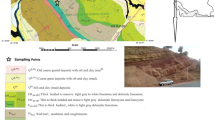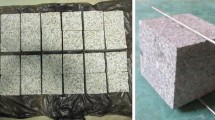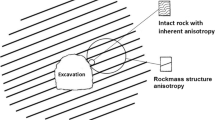Abstract
Anisotropy affects the measurements of uniaxial compressive and tensile strengths due to the presence of the weakness planes such as schistosity and foliation surfaces. Such rocks have different anisotropy behavior. The requirement for a more sensitive anisotropy classification which takes into account more parameters in the analytical approach promoted this study. It is recommended that the length of the curve obtained from the relationship between the orientation angles of schistose planes of anisotropic rocks and the uniaxial compressive, and tensile strengths should be examined separately. Variations both for compressive and tensile strengths of anisotropic rocks at different schistose plane orientations were investigated by curve length measurement method. The proposed definition in this study is based on the curve length (arc length) of the quadratic polynomial that fits all the data. The curve length concept has been associated for the first time with the anisotropy behavior of rocks in this study. The length of the curve reflects the degree of anisotropy in rocks because it is a precisely computable parameter. The curve length is constant for any kind of anisotropic rock; accordingly, each rock with anisotropy will have a unique function of degree two. In addition, as the degree of curvature increases, the length of the curve and the effect of anisotropy on the schistose rocks also increase. The aforementioned feature allows the precise comparison of the curve lengths of different anisotropic rocks. In this study, a new anisotropy classification method was proposed for the determination of the degree of anisotropy of rocks based on the length of the curve and the difference of strength between σcmax and σcmin values of the curve. The concept of Rt ratio, which is the anisotropy ratio under the tension stress, was introduced for the first time and applied in this study. While the mean curve length for the phyllites was 92.64±0.64, this value for the schists was 90.23±0.14. Thus, it was understood that the effect of anisotropy on the phyllites is higher than that of the schists in terms of tensile strength. The mean decreases in strength in phyllites and schists were also determined as 86% and 70.2%, respectively.

















Similar content being viewed by others
References
Adams RA, Essex C (2010) Calculus (a complete course), Seventy Edition, Pearson, Canada – Toronto, p. 973
Akai K (1971) The failure surface of isotropic and anisotropic rocks under multiaxial stresses. J. Society Mater Sci. Jpn. 20(209):122–128
Aydın S (2018) Investigation of the anisotropy behavior of schists: case study, mica schists from Urkmez dam site, Graduate thesis, Dokuz Eylül University, Engineering Faculty, Geological Enginering Dept. Izmir/Turkey, s. 60
Behrestaghi MHN, Rao KS, Ramamurthy T (1996) Engineering geological and geotechnical responses of schistose rocks from dam project areas in India. Eng. Geo. 44(1-4):183–201
Elçi H (2003) Engineering geology of the Izmir-Selcuk District, Master of Science Thesis, Dokuz Eylul University, The Graduate School of Natural and Applied Sciences, p. 210
Esamaldeen A, Guang W, Zhiming Z (2014) Assessment of strength anisotropy and deformation behavior of banded amphibolite rocks. Geotech. Geol. Eng. 32:429–438
Hobbs DW (1963) The tensile strength of rocks. Int. J. Rock Mech. Mining Sci. 1:385–396
ISRM (2007a) Suggested methods prepared by the commission on testing methods, uniaxial compression test, International Society for Rock Mechanics, p. 221-229
ISRM (2007b) Suggested method for determining tensile strength of rock materials, suggested methods prepared by the commission on testing methods, International Society for Rock Mechanics, p. 181-183
Jin Z, Li W, Jin C, Hambleton J, Cusatis G (2017) Elastic, strength and fracture properties of Marcellus shale, Int. J. Rock Mech. Min. Sci. 1 – 20
Karakul H (2007) Strength anisotropy research on disc shear ındex test, Master of science thesis, Hacettepe University, Ankara, p. 67
MATLAB (2022) Version R2022a. Natick, Massachusetts: The MathWorks Inc. https://www.mathworks.com
Ma T, Peng N, Zhu Z, Zhang Q, Yang C, Zhaoi J (2018) Brazillian tensile strength of anisotropic rocks. Energies 11:304. https://doi.org/10.3390/en11020304
Mokhtari M, Tutuncu AN (2016) Impact of laminations and natural fractures on rock failure in Brazillian experiments. a case study on Green River and Niobrara formations, Jour. Of Natural Gas Sci. And Eng., Vol. 36, Part A, 79 – 86
M.T.A (2000) Directorate of mineral research and exploration. The geological map of Turkey, Ankara
Nasseri MH, Rao KS, Ramamurthy T (1997) Failure mechanism in schistose rocks. Int. J. Rock Mech. Min. Sci. 34:3–4
Nasseri MH, Rao KS, Ramamurthy T (2003) Anisotropic strength and deformational behaviour of Himalayan schists. Int. J. Rock Mech. Min. Sci. 40(1):3–23
Papadopoulas Z, Marinos P (1992) On the anisotropy of the Athenian schist and its relation to weathering, Bull. Int. Assoc. Eng. Geol. No. 45, Paris, 111-116
Ramamurthy T, Rao GV, Singh J (1993) Engineering behaviour of phyllites. Eng. Geo. 33:209–225
Sabatakakis N, Tsiambaos G (1983) Anisotropy of Central Macedonia phyllite and its effect on the uniaxial compressive strength. Bull PWRC 1–2:26–32
Saroglou H, Marinos P, Tsiambaos G (2004) Applicability of the Hoek-Brown failure criterion and the effect of the anisotropy on intact rock samples from Athens schist, The Journal of the South African Ins. of Min. And Metall. P. 209 – 215
Singh J, Ramamurthy T, Rao GV (1989) Strength anisotropies in rocks. India Geotech. J. 19(2):147–166
Singh VK, Singh D, Singh TN (2001) Prediction of strength properties of some schistose rocks from petrographic properties using artificial neural networks. Int J Rock Mech Mining Sci 38(2):269–284
Sokolnikof IS, Redheffer RM (1966) Mathematics of physics and modern engineering. Mc Graw-Hill Book Company, New York, p 752
Uslu S (2017) Engineering geology of the rock slope on the right bank of the Burgaz-Izmir dam site, Master of science Thesis, Dokuz Eylul University, The Graduate School of Natural and Applied Sciences, Izmir/Turkey, p. 97
Zhang XP, Wong LNY, Wang SJ, Han GY (2011) Engineering properties of quartz mica schist. Eng. Geo. 121:135–149
Author information
Authors and Affiliations
Corresponding author
Ethics declarations
Conflict of interest
The authors declare no competing interests.
Additional information
Responsible Editor: Murat Karakus
Rights and permissions
Springer Nature or its licensor holds exclusive rights to this article under a publishing agreement with the author(s) or other rightsholder(s); author self-archiving of the accepted manuscript version of this article is solely governed by the terms of such publishing agreement and applicable law.
About this article
Cite this article
Koca, M.Y., Kıncal, C. A new approach to the anisotropy classification based on curve length measurement method: a case study in Ürkmez dam site-İzmir, Türkiye. Arab J Geosci 15, 1456 (2022). https://doi.org/10.1007/s12517-022-10614-4
Received:
Accepted:
Published:
DOI: https://doi.org/10.1007/s12517-022-10614-4




